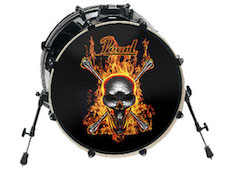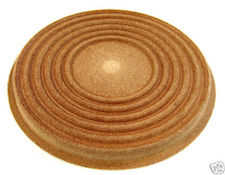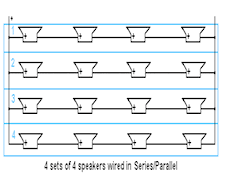It’s the time of year for saving money!
Last time in this continuing series, I wrote about some of the things that could be done with speakers or their drivers to gain better diaphragm control, reduce diaphragm “overshoot” and “undershoot”, reduce the dynamic compression and information loss that results from them, and get better overall dynamics, better transient response, and a “kickier” kick drum sound.
 Among the things that could be done, I wrote, were to build drivers with “motors” (the part that moves the diaphragm to move the air to make the sound) that were more powerful relative to the mass they have to move (the diaphragm and the moving parts of the “spider” and “surround”), either by making the motors bigger or stronger, by making the parts to be moved less massy, or by some combination of both ― perhaps the use of more than one (smaller) driver for a particular function, for example, instead of just a single larger one. This could both increase total available motor power and, at the same time, reduce the amount of mass any single motor would need to control.
Among the things that could be done, I wrote, were to build drivers with “motors” (the part that moves the diaphragm to move the air to make the sound) that were more powerful relative to the mass they have to move (the diaphragm and the moving parts of the “spider” and “surround”), either by making the motors bigger or stronger, by making the parts to be moved less massy, or by some combination of both ― perhaps the use of more than one (smaller) driver for a particular function, for example, instead of just a single larger one. This could both increase total available motor power and, at the same time, reduce the amount of mass any single motor would need to control.
Something else that could be done, I said, was to make the “spring” elements of the driver (the spider, and surround of conventional cone or dome drivers and the air trapped in the enclosure of an “acoustic suspension” speaker system) “stiffer” so that it would be harder for the diaphragm to move either forward or backward, away from its center “rest” position. Although this could help to control overshoot, it could also, as I told you, increase the driver’s tendency to undershoot and cancel-out whatever potential benefit it might otherwise offer.
All of the things just mentioned can provide a LINEAR increase in a driver’s (or in the case of acoustic suspension, a driver/enclosure system’s) ability to control its diaphragm, and any doubling or halving of relative motor power, of moving element mass, or of effective spring tension will result in a corresponding doubling or halving of the effective force available from that control factor. The problem, though, is that the amount of force NECESSARY to control the diaphragm’s movement is NOT LINEAR, but increases or decreases as THE SQUARE OF any change in diaphragm velocity, and any doubling or halving of that velocity will require either FOUR TIMES or just ONE QUARTER as much force to control. Because of that, the very best place to look for improvement in a driver’s ability to follow its driving signal exactly, with neither overshoot nor undershoot and with no resultant dynamic compression or loss of other information, is not in any of those linear control factors, but simply in reducing the diaphragm’s velocity of travel.
 Although the term may sound daunting, the “velocity of travel” of a driver’s diaphragm is nothing more than simply the total of all of its (back and forth) movement over any given period of time (usually one second. As should be obvious, the velocity of travel of a diaphragm trying to follow a music signal changes constantly, increasing or decreasing with every increase or decrease in signal frequency or amplitude (read “loudness” or “volume”), and can be reduced (for easier diaphragm control at a rate equal to the square of the reduction in instantaneous travel velocity at any given moment) in a number of ways: Among these are simply to reduce either or both the volume or the frequency of the driving audio signal, but because of their effect on either or both our enjoyment of the music or its accuracy of reproduction, turning down the volume or chopping-off the highs are probably not practical solutions.
Although the term may sound daunting, the “velocity of travel” of a driver’s diaphragm is nothing more than simply the total of all of its (back and forth) movement over any given period of time (usually one second. As should be obvious, the velocity of travel of a diaphragm trying to follow a music signal changes constantly, increasing or decreasing with every increase or decrease in signal frequency or amplitude (read “loudness” or “volume”), and can be reduced (for easier diaphragm control at a rate equal to the square of the reduction in instantaneous travel velocity at any given moment) in a number of ways: Among these are simply to reduce either or both the volume or the frequency of the driving audio signal, but because of their effect on either or both our enjoyment of the music or its accuracy of reproduction, turning down the volume or chopping-off the highs are probably not practical solutions.
What IS a practical solution is to increase the number of drivers playing (either “full-range” or in each frequency range ― woofer, mid-range, tweeter or super-tweeter ― of) what we want to listen to. This will do nothing in itself, but because each doubling in the number of drivers (more woofers; more mid-ranges; more tweeters or more full-range drivers) will produce a (theoretical and often actual) loudness increase of 6dB at any same level of input power, it will allow us to reduce the amount of signal power that is needed to produce the sound pressure level (“SPL”) we want to listen to, and that reduction in power will result in a reduction of diaphragm travel and corresponding diaphragm velocity. For each 6dB reduction in power (each “quartering” of the power ) to each of the paired (“doubled”) drivers, we will reduce that driver’s diaphragm travel and resultant velocity by HALF, which ― depending on how you choose to state it ― will either reduce the force required to control the driver’s diaphragm to just one quarter (1/4) of that required for a single driver operating at that same level or increase the available control force’s effectiveness by 400%!
 Making the use of more than one driver per frequency range even more desirable is the fact that we can KEEP ON DOUBLING the number of drivers (4 drivers instead of 2; 8 instead of 4; 16 instead of 8, and so on) and, if we do, we’ll keep on gaining similar results. I suggested last time that that might be one of the reasons why companies like McIntosh, Cello, Carver, JBL and others use so many drivers in their “line source” speakers.
Making the use of more than one driver per frequency range even more desirable is the fact that we can KEEP ON DOUBLING the number of drivers (4 drivers instead of 2; 8 instead of 4; 16 instead of 8, and so on) and, if we do, we’ll keep on gaining similar results. I suggested last time that that might be one of the reasons why companies like McIntosh, Cello, Carver, JBL and others use so many drivers in their “line source” speakers.
The use of multiple drivers does offer advantages in terms of diaphragm control, but it can also have its negative side: Where multiple drivers provide multiple “launch points” for the same tone spaced more than a wavelength apart, it’s possible, especially at higher frequencies, for different timing (“effective phase”) effects to produce “comb filtering” and “acoustical interference” that will affect the speaker system’s frequency response and/or dispersion pattern.. Panel or “ribbon-type” speakers can help to alleviate these problems by acting as a single very large launch point. The listener’s ear will still be at different distances from different points on the panel or along the ribbon, but “Haas Precedence Effects” will usually work to minimize audible problems.
 Another point in favor of panel (such as large Electrostatics, Magnepans, E-Ts, and the like) and some ribbon speakers (like the big Apogees) is that they are, by their nature “low velocity” devices, and thus inherently less prone to diaphragm overshoot or undershoot than cones or domes.
Another point in favor of panel (such as large Electrostatics, Magnepans, E-Ts, and the like) and some ribbon speakers (like the big Apogees) is that they are, by their nature “low velocity” devices, and thus inherently less prone to diaphragm overshoot or undershoot than cones or domes.
I’ll talk more about them in the next installment and, given sufficient time and space, I’ll also try to write a little about horn speakers, which, surprisingly, can offer some of the same benefits.
See you then.





